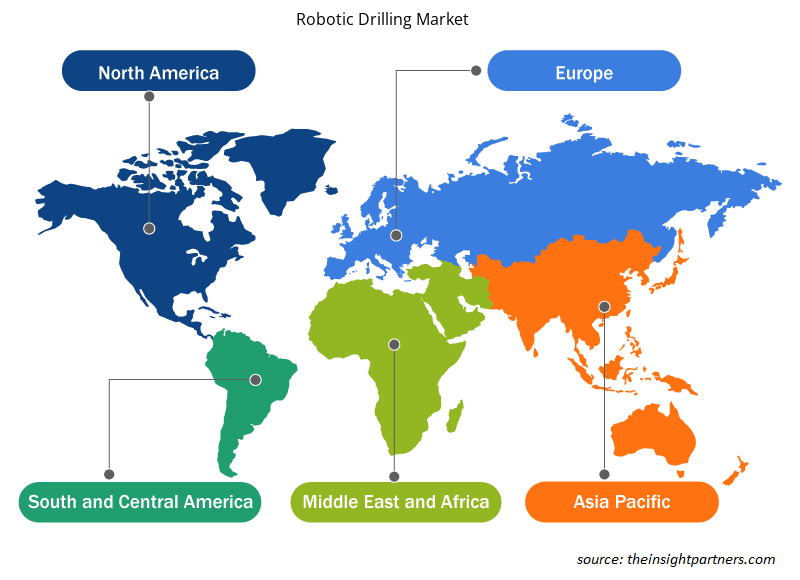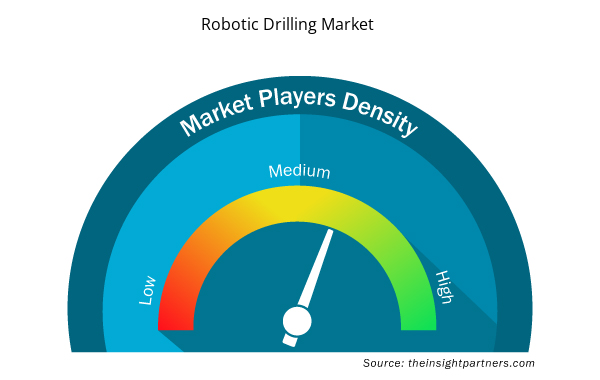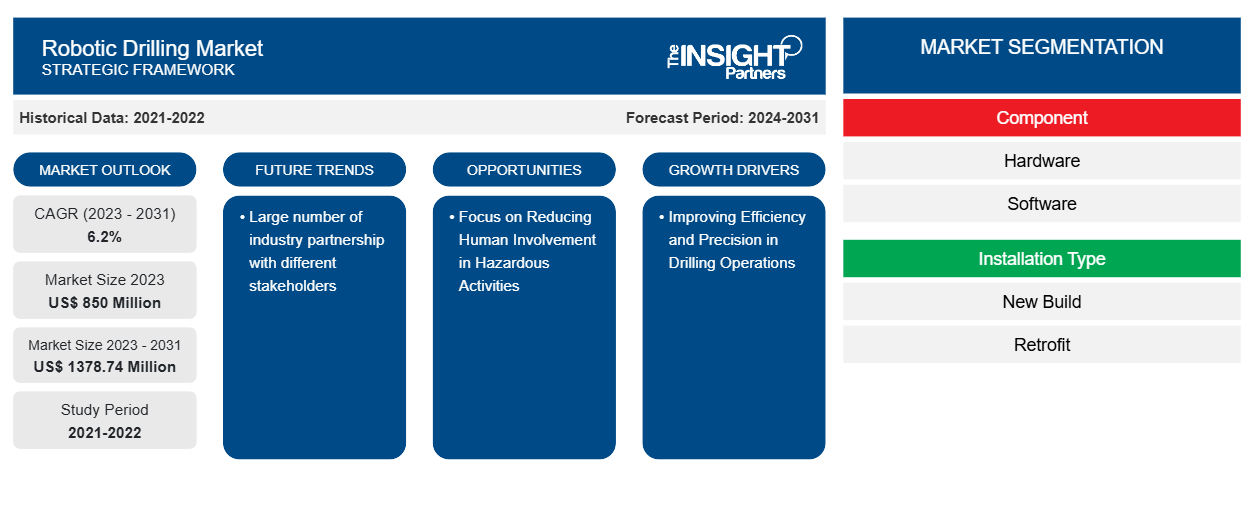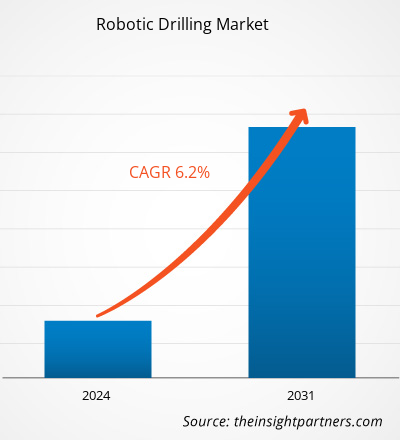机器人钻井市场规模预计将从 2023 年的 8.5 亿美元增至 2031 年的 13.7874 亿美元。预计 2023-2031 年市场复合 年增长率为 6.2%。钻井活动的增加主要推动了市场扩张,因为开发了优质的碳氢化合物资源,并在石油和天然气钻井中实施了自动化和机器人。这提高了效率并提高了钻井平台的安全性。
机器人钻孔市场分析
预计,勘探活动的增加以及对以无风险、经济高效和省时的方式开发新油气田的关注将推动机器人钻井系统市场的发展。然而,近年来油价波动、网络安全问题和高昂的初始成本抑制了机器人钻井行业的增长。
机器人钻孔市场概况
机器人钻井是自主钻井作业的领先技术。钻井机器人控制可确保安全高效的操作,同时减少人为错误。随着人口和城市的增长,世界对化石燃料的依赖导致对石油和天然气的需求迅速增加。这导致钻井活动激增。机器人钻井在石油和天然气勘探中的使用正在增加,由于工业化程度的提高和非常规碳氢化合物储量的开采,该行业可能会扩大。发电量的扩大,特别是在新兴经济体,预计将促进市场增长。此外,机器人技术的发展起到了间接驱动作用,加速了机器人钻井市场的增长轨迹。
定制此报告以满足您的需求
您可以免费定制任何报告,包括本报告的部分内容、国家级分析、Excel 数据包,以及为初创企业和大学提供优惠和折扣
- 获取此报告的关键市场趋势。这个免费样品将包括数据分析,从市场趋势到估计和预测。
机器人钻井市场驱动因素和机遇
提高钻井作业效率和精度以赢得市场
在石油和天然气、采矿和生产等众多行业中,钻井作业不断追求作业效率和精度。机器人钻井系统可提高精度、减少人为错误并提高标准生产率。钻井作业中最重要的因素是安全性,因为机器人结构可减少人类暴露于危险环境中,尤其是在海上和困难地形中。
注重减少人类参与危险活动
为了限制人类接触危险的钻井场景,公司优先考虑机器人钻井领域的安全和风险缓解。传统的钻井作业,通常是石油和天然气勘探、采矿和建筑等行业,依靠人类工人执行体力要求高且有风险的任务。机器人钻井技术使钻井作业更加安全,改变了商业格局。机器人钻井降低了人类参与危险钻井活动的需要。这些作业通常在具有挑战性或偏远的地方进行,例如危险的矿山、海上石油钻井平台或深海平台。
在这些情况下,员工面临各种风险,包括事故、接触有毒产品和极端天气。企业可以使用机器人钻孔设备来降低风险并提高员工安全性。
机器人钻孔市场报告细分分析
有助于得出机器人钻孔市场分析的关键部分是组件、安装类型和应用。
机器人钻孔市场份额(按地区)分析
机器人钻井市场报告的地理范围主要分为五个区域:北美、亚太、欧洲、中东和非洲以及南美/南美和中美。由于北美最近页岩气的开发,机器人钻井设备市场急剧增长。墨西哥湾的勘探活动也在增加,这推动了区域机器人钻井系统市场的发展。钻井成本的降低和油价的上涨导致美国海上钻井平台数量和石油产量大幅增加,这表明海上钻井将扩大,这预计将成为该国机器人钻井市场的主要推动力。
机器人钻孔市场区域洞察
Insight Partners 的分析师已详细解释了预测期内影响机器人钻井市场的区域趋势和因素。本节还讨论了北美、欧洲、亚太地区、中东和非洲以及南美和中美洲的机器人钻井市场细分和地理位置。

- 获取机器人钻孔市场的区域特定数据
机器人钻孔市场报告范围
| 报告属性 | 细节 |
|---|---|
| 2023 年的市场规模 | 8.5亿美元 |
| 2031 年市场规模 | 13.7874亿美元 |
| 全球复合年增长率(2023 - 2031) | 6.2% |
| 史料 | 2021-2022 |
| 预测期 | 2024-2031 |
| 涵盖的领域 | 按组件
|
| 覆盖地区和国家 | 北美
|
| 市场领导者和主要公司简介 |
|
机器人钻井市场参与者密度:了解其对业务动态的影响
机器人钻孔市场正在快速增长,这得益于终端用户需求的不断增长,而这些需求又源于消费者偏好的不断变化、技术进步以及对产品优势的认识不断提高等因素。随着需求的增加,企业正在扩大其产品范围,进行创新以满足消费者的需求,并利用新兴趋势,从而进一步推动市场增长。
市场参与者密度是指在特定市场或行业内运营的企业或公司的分布情况。它表明相对于给定市场空间的规模或总市场价值,有多少竞争对手(市场参与者)存在于该市场空间中。
在机器人钻孔市场运营的主要公司有:
- 贝克休斯
- 斯伦贝谢
- 哈里伯顿
- 毛虫
- 国民油井华高公司
- 阿特拉斯·科普柯
免责声明:上面列出的公司没有按照任何特定顺序排列。

- 了解机器人钻孔市场的主要参与者概况
机器人钻孔市场新闻和最新发展
通过收集一手和二手资料后获得的定性和定量数据来评估机器人钻孔市场,这些资料包括重要的公司出版物、协会数据和数据库。以下是市场发展情况的列表:
- 2021 年 3 月,斯伦贝谢获得了一份价值 4.8 亿美元的合同,为巴士拉石油公司和埃克森美孚在伊拉克南部钻探 96 口油井,这两家公司与伊拉克、日本、印度尼西亚和中国的合作伙伴共同经营规模庞大的西古尔纳 1 号油田。
(来源:斯伦贝谢,公司网站,2021 年)
- 2021 年 10 月,Nabors Industries Ltd 推出了配备 Canrig 机器人的 PACE-R801 全自动陆地钻机。它在 Permian 盆地的第一口井就达到了完整的深度。它设计了一个自动化钻台,以消除红区位置的工作人员并提供恒定的钻井性能。
(来源:Nabors Industries Ltd,公司网站,2021 年)
机器人钻井市场报告范围和交付成果
“机器人钻井市场规模和预测(2021-2031 年)”报告对以下领域进行了详细的市场分析:
- 范围内所有主要细分市场的全球、区域和国家层面的市场规模和预测
- 市场动态,如驱动因素、限制因素和关键机遇
- 未来主要趋势
- 详细的 PEST/波特五力分析和 SWOT 分析
- 全球和区域市场分析涵盖关键市场趋势、主要参与者、法规和最新市场发展
- 行业格局和竞争分析,涵盖市场集中度、热点图分析、知名参与者和最新发展
- 详细的公司简介
- 历史分析(2 年)、基准年、预测(7 年)及复合年增长率
- PEST 和 SWOT 分析
- 市场规模价值/数量 - 全球、区域、国家
- 行业和竞争格局
- Excel 数据集


- Virtual Production Market
- Health Economics and Outcome Research (HEOR) Services Market
- Explosion-Proof Equipment Market
- Grant Management Software Market
- Legal Case Management Software Market
- Organoids Market
- Drain Cleaning Equipment Market
- Third Party Logistics Market
- Batter and Breader Premixes Market
- Influenza Vaccines Market

Report Coverage
Revenue forecast, Company Analysis, Industry landscape, Growth factors, and Trends

Segment Covered
This text is related
to segments covered.

Regional Scope
North America, Europe, Asia Pacific, Middle East & Africa, South & Central America

Country Scope
This text is related
to country scope.
常见问题
The global robotic drilling market is expected to reach US$ 1378.74 million by 2031.
The key players holding the majority of shares in the global robotic drilling market are Baker Hughes, Schlumberger, Halliburton, Caterpillar, and National Oilwell Varco.
A large number of industry partnerships with different stakeholders to play a significant role in the global robotic drilling market in the coming years.
Improving efficiency and precision in drilling operations are the major factors that propel the global robotic drilling market.
The global robotic drilling market was estimated to be US$ 850 million in 2023 and is expected to grow at a CAGR of 6.2% during the forecast period 2023 - 2031.
Trends and growth analysis reports related to Electronics and Semiconductor : READ MORE..
The Insight Partners performs research in 4 major stages: Data Collection & Secondary Research, Primary Research, Data Analysis and Data Triangulation & Final Review.
- Data Collection and Secondary Research:
As a market research and consulting firm operating from a decade, we have published and advised several client across the globe. First step for any study will start with an assessment of currently available data and insights from existing reports. Further, historical and current market information is collected from Investor Presentations, Annual Reports, SEC Filings, etc., and other information related to company’s performance and market positioning are gathered from Paid Databases (Factiva, Hoovers, and Reuters) and various other publications available in public domain.
Several associations trade associates, technical forums, institutes, societies and organization are accessed to gain technical as well as market related insights through their publications such as research papers, blogs and press releases related to the studies are referred to get cues about the market. Further, white papers, journals, magazines, and other news articles published in last 3 years are scrutinized and analyzed to understand the current market trends.
- Primary Research:
The primarily interview analysis comprise of data obtained from industry participants interview and answers to survey questions gathered by in-house primary team.
For primary research, interviews are conducted with industry experts/CEOs/Marketing Managers/VPs/Subject Matter Experts from both demand and supply side to get a 360-degree view of the market. The primary team conducts several interviews based on the complexity of the markets to understand the various market trends and dynamics which makes research more credible and precise.
A typical research interview fulfils the following functions:
- Provides first-hand information on the market size, market trends, growth trends, competitive landscape, and outlook
- Validates and strengthens in-house secondary research findings
- Develops the analysis team’s expertise and market understanding
Primary research involves email interactions and telephone interviews for each market, category, segment, and sub-segment across geographies. The participants who typically take part in such a process include, but are not limited to:
- Industry participants: VPs, business development managers, market intelligence managers and national sales managers
- Outside experts: Valuation experts, research analysts and key opinion leaders specializing in the electronics and semiconductor industry.
Below is the breakup of our primary respondents by company, designation, and region:

Once we receive the confirmation from primary research sources or primary respondents, we finalize the base year market estimation and forecast the data as per the macroeconomic and microeconomic factors assessed during data collection.
- Data Analysis:
Once data is validated through both secondary as well as primary respondents, we finalize the market estimations by hypothesis formulation and factor analysis at regional and country level.
- Macro-Economic Factor Analysis:
We analyse macroeconomic indicators such the gross domestic product (GDP), increase in the demand for goods and services across industries, technological advancement, regional economic growth, governmental policies, the influence of COVID-19, PEST analysis, and other aspects. This analysis aids in setting benchmarks for various nations/regions and approximating market splits. Additionally, the general trend of the aforementioned components aid in determining the market's development possibilities.
- Country Level Data:
Various factors that are especially aligned to the country are taken into account to determine the market size for a certain area and country, including the presence of vendors, such as headquarters and offices, the country's GDP, demand patterns, and industry growth. To comprehend the market dynamics for the nation, a number of growth variables, inhibitors, application areas, and current market trends are researched. The aforementioned elements aid in determining the country's overall market's growth potential.
- Company Profile:
The “Table of Contents” is formulated by listing and analyzing more than 25 - 30 companies operating in the market ecosystem across geographies. However, we profile only 10 companies as a standard practice in our syndicate reports. These 10 companies comprise leading, emerging, and regional players. Nonetheless, our analysis is not restricted to the 10 listed companies, we also analyze other companies present in the market to develop a holistic view and understand the prevailing trends. The “Company Profiles” section in the report covers key facts, business description, products & services, financial information, SWOT analysis, and key developments. The financial information presented is extracted from the annual reports and official documents of the publicly listed companies. Upon collecting the information for the sections of respective companies, we verify them via various primary sources and then compile the data in respective company profiles. The company level information helps us in deriving the base number as well as in forecasting the market size.
- Developing Base Number:
Aggregation of sales statistics (2020-2022) and macro-economic factor, and other secondary and primary research insights are utilized to arrive at base number and related market shares for 2022. The data gaps are identified in this step and relevant market data is analyzed, collected from paid primary interviews or databases. On finalizing the base year market size, forecasts are developed on the basis of macro-economic, industry and market growth factors and company level analysis.
- Data Triangulation and Final Review:
The market findings and base year market size calculations are validated from supply as well as demand side. Demand side validations are based on macro-economic factor analysis and benchmarks for respective regions and countries. In case of supply side validations, revenues of major companies are estimated (in case not available) based on industry benchmark, approximate number of employees, product portfolio, and primary interviews revenues are gathered. Further revenue from target product/service segment is assessed to avoid overshooting of market statistics. In case of heavy deviations between supply and demand side values, all thes steps are repeated to achieve synchronization.
We follow an iterative model, wherein we share our research findings with Subject Matter Experts (SME’s) and Key Opinion Leaders (KOLs) until consensus view of the market is not formulated – this model negates any drastic deviation in the opinions of experts. Only validated and universally acceptable research findings are quoted in our reports.
We have important check points that we use to validate our research findings – which we call – data triangulation, where we validate the information, we generate from secondary sources with primary interviews and then we re-validate with our internal data bases and Subject matter experts. This comprehensive model enables us to deliver high quality, reliable data in shortest possible time.


 获取此报告的免费样本
获取此报告的免费样本